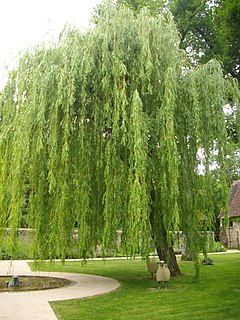
Willows, also called sallows and osiers, from the genus Salix, comprise around 400 species of typically deciduous trees and shrubs, found primarily on moist soils in cold and temperate regions.

Salix alba, the white willow, is a species of willow native to Europe and western and central Asia. The name derives from the white tone to the undersides of the leaves.

Salix purpurea, the purple willowpurpleosier willow or purple osier, is a species of willow native to most of Europe and western Asia north to the British Isles, Poland, and the Baltic States.

Salix × fragilis, with the common names crack willow and brittle willow, is a hybrid species of willow native to Europe and Western Asia. It is native to riparian habitats, usually found growing beside rivers and streams, and in marshes and water meadow channels. It is a hybrid between Salix euxina and Salix alba, and is very variable, with forms linking both parents.

Salix viminalis, the basket willow, common osier or osier, is a species of willow native to Europe, Western Asia, and the Himalayas.

Salix amygdaloides, the peachleaf willow, is a species of willow native to central North America east of the Cascade Range. It can be found in southern Canada and the United States—from western British Columbia to Quebec, Idaho, Montana and Arizona to eastern Kentucky.

Salix babylonica is a species of willow native to dry areas of northern China, but cultivated for millennia elsewhere in Asia, being traded along the Silk Road to southwest Asia and Europe.

Salix integra is a species of willow native to north-eastern China, Japan, Korea and the far south-eastern Russia.
Trophic cascades are powerful indirect interactions that can control entire ecosystems, occurring when a trophic level in a food web is suppressed. For example, a top-down cascade will occur if predators are effective enough in predation to reduce the abundance, or alter the behavior of their prey, thereby releasing the next lower trophic level from predation.

Salix lasiolepis is a species of willow native to western North America.

Salix exigua is a species of willow native to most of North America except for the southeast and far north, occurring from Alaska east to New Brunswick, and south to northern Mexico. It is considered a threatened species in Massachusetts while in Connecticut, Maryland, and New Hampshire it is considered endangered.

Cryptogramma cascadensis is a species of fern known by the common names Cascade parsley fern and Cascade rockbrake.

Salix geyeriana is a species of willow known by the common names Geyer's willow, Geyer willow and silver willow. The type specimen was collected by the botanist Karl Andreas Geyer, for whom it was named. Its conspicuous, yellow flowers begin to bloom as early as March, to as late as the end of June.

Salix brachycarpa is a species of flowering plant in the willow family known by the common names barren-ground willow, small-fruit willow and shortfruit willow.

Fragaria cascadensis is a species of strawberry found in the Cascades Mountains described in 2012. The vernacular name Cascade strawberry was suggested by the describing author.

Salix wolfi, or Wolf's willow, is a species of willow native to western United States, from north-central Montana and central Oregon to northern New Mexico.

Salix tweedyi, or Tweedy's willow, is a shrub in the willow family. It is native to the northwestern United States.

Salix pyrifolia, the balsam willow, is a species of flowering plant in the family Salicaceae, native to Canada, and the north-central to northeastern United States. A shrub, its leaves emit a balsam-like fragrance. It is available from commercial suppliers.
















